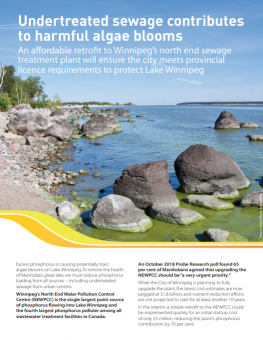
Undertreated Sewage Contributes to Harmful Algal Blooms
In this short brochure, the Lake Winnipeg Foundation and the International Institute for Sustainable Development, present their plans for an interim solution to Winnipeg's phosphorus woes.
Excess phosphorus is causing potentially toxic algae blooms on Lake Winnipeg. To restore the health of Manitoba’s great lake, we must reduce phosphorus loading from all sources – including undertreated sewage from urban centres.
Research at IISD Experimental Lakes Area shows that phosphorus is the nutrient responsible for potentially toxic algae blooms in freshwater lakes.
Winnipeg’s North End Water Pollution Control Centre is the single largest point source of phosphorus flowing into Lake Winnipeg and the fourth largest phosphorus polluter among all wastewater treatment facilities in Canada.
An October 2018 Probe Research poll found 65 per cent of Manitobans agreed that upgrading the NEWPCC should be “a very urgent priority.”
While the City of Winnipeg is planning to fully upgrade the plant, the latest cost estimates are now pegged at $1.8 billion, and nutrient-reduction efforts are not projected to start for at least another 10 years.
In the interim, a simple retrofit to the NEWPCC could be implemented quickly for an initial startup cost of only $5 million, reducing the plant’s phosphorus contribution by 70 per cent.
In this short brochure, the Lake Winnipeg Foundation and the International Institute for Sustainable Development, present their plans for an interim solution.
You might also be interested in
Way to Go Winnipeggers
Winnipeg is getting even closer to increasing the protection of Lake Winnipeg from harmful algal blooms. And it's thanks to Winnipeggers of all stripes!
Netley-Libau Nutrient-Bioenergy Project
The Manitoba Challenge: Linking Water and Land Management for Climate Adaptation
Ecological watershed management is a key to successful climate adaptation in Manitoba, and will also help improve the state of Lake Winnipeg.
What Is the UAE Framework for Global Climate Resilience, and How Can Countries Move It Forward?
With the introduction of the new framework for the Global Goal on Adaptation (GGA), COP 28 marked a milestone for adaptation. We unpack key outputs and set out how countries can move forward by strengthening their national monitoring, evaluation, and learning (MEL) systems.